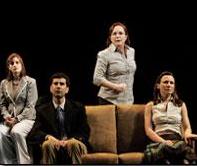SITE GUIDE
REVIEWS
FEATURES
NEWS
Etcetera and
Short Term Listings
LISTINGS
Broadway
Off-Broadway
NYC Restaurants
BOOKS and CDs
OTHER PLACES
Berkshires
London
California
DC
Philadelphia
Elsewhere
QUOTES
On TKTS
PLAYWRIGHTS' ALBUMS
LETTERS TO EDITOR
FILM
LINKS
MISCELLANEOUS
Free Updates
Masthead
Writing for Us SEARCH
A CurtainUp Review
cul-de-sac
By Elyse Sommer
| There was a survey. It was conducted. And. . . it found that people are getting tired of the 'relentless pursuit of happiness in which most of us are engaged. . . and coming up short in life.' --- Jill Johnson |

(L-R) Robyn Hussa, John Cariani, Monica Russell, Nicole Alifante, two of the four couples living in the same cul-de-sac
|
John Cariani's second play is like a dark twin to his charming fledgling playwriting venture, Almost Maine (see link below). The characters in both plays are connected by their location. However, instead of the quirky humor and bracing sense of hope that overhung the residents of the wintry Maine town of Almost (similar to the one in which Cariani grew up), the three couples living in adjoining houses of a suburban cul-de-sac in anywhere USA are bound together less by a sense of place than a growing feeling of despair and displacement.
These disappointed suburban dreamers are all clinging to the shards of their shattered vision of fully realized lives where love and romance maintain their glow, careers flourish and children arrive and bring joy as planned. But the occasional touch of fantasy added to Almost Maine's charm and optimism, in cul-de-sac veers towards the bizarre so that it ends up being less the dark comedy it sets out to be than a modern tragedy.
Unfortunately, the structure of the play also works against its holding our interest. The ninety minutes are divided into half-hour long (but feeling much longer) peeks into each home on the same Friday night. The final episode is with the aptly named Joneses, whose cars and children and weekly living room dance sessions set the Johnsons' and Smiths' to thoughts about having been left behind in the getting it all game of life. The overlapping interchanges between each couple emphasize the disconnect in the relationships. Keeping the characters not in the front and center situation on stage like human props helps to build up what connects their stories. But while this lends itself to stylish expressionistic staging, it also traps the whole enterprise into being too repetitious.
With considerable help from Sandra Goldmark's scenic design and R. Lee Kennedy's lighting, director Cummings has taken full advantage of the script's stylistic potential. But once we move from the Johnsons to the Smiths, everything blurs into one long replay of the same problem with the characters' individuality sacrificed to the idea of variations on a single theme: The effect of time and buying into the busy, non-contemplative American success pattern on a couple's initial vision of happiness. The focus in each segment is on the mundane daily decisions about what to have for dinner (pizza being the all-around choice); sex (rare if ever is yet another common denominator); and children (never born children cause Jill Johnson's biological clock to tick too furiously to sympathize with her husband's aborted career dream, a tragic act of neglect keeps Christy Smith bedbound and the demands of twins proves too much of a good thing, driving Irene and Joe Jones over the edge of normal behavior).
Robyn Hussa and John Wellmann as Jill and Roger Johnson ably handle the challenge of the overlapping dialogue in the first and most interesting episode, but even that goes on too long to prevent its becoming irritating. Monica Russell and James Weber are less successful in portraying Christy and James Smith but then they also have less believable characters to deal with. I kept hoping that the Irene and Joe Jones final segment (in which the playwright dons his actor's hat) would break the pattern of predictability, but alas, the Johnsons' and Smiths' are envying the wrong Joneses. Their neighbors are as miserable as they are-- and their way of dealing with their unhappiness is more crazy than credible though kudos is due the actors for their performances.
It's not uncommon for an author to have to recapture that special something of a much praised first work. So chalk cul-de-sac up to a phase two stumble and look for John Cariani to regain his footing with his next play. The same can be said for the Transport Group which has brought us enough unique and memorable productions to overlook an occasional so-so effort. Despite not being on a par with Transport's Our Town, Requiem for William, First Lady Suite and The Audience, cul-de-sac does deliver on the company's mission to integrate music even with their non-musical offerings , courtesy of Tom Kochan's original score performed by John DiPinto.
LINKS
Almost Maine
Our Town
Requiem for William
First Lady Suite
|
CUL-DE-SAC Playwright: John Cariani. Directed by Jack Cummings III Cast: Nicole Alifante (Irene Jones), John Cariani (Joe Jones), Robyn Hussa (Jill Johnson), Monica Russell (Christy Smith), James Weber (James Smith) and John Wellmann (Roger Johnson). Set Design: Sandra Goldmark Costume Design: Kathryn Rohe Lighting Design: R. Lee Kennedy Sound Design: Seth Guterman Original Music: Tom Kochan Running time: 90 minutes without intermission Transport Group at the Connelly Theatre, 220 East 4 Street (212) 352-3101 www.transport-group.org. From 4/20/06 to 5/13/06; opening 4/30/06. Tuesday through Saturday at 8pm, Saturday at 2pm, and Sunday at 3pm. Tickets: $19 Reviewed by Elyse Sommer based on April 29th press performance |
The Internet Theatre Bookshop "Virtually Every Play in the World" --even out of print plays

Easy-on-the budget super gift for yourself and your musical loving friends. Tons of gorgeous pictures.
Leonard Maltin's 2005 Movie Guide

6, 500 Comparative Phrases including 800 Shakespearean Metaphors by our editor.
Click image to buy.
Go here for details and larger image.








